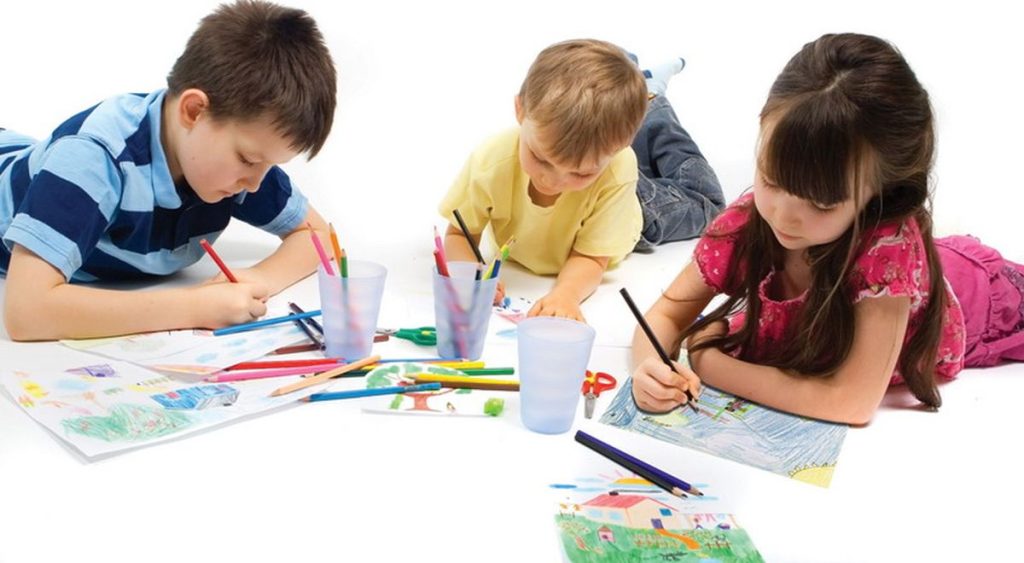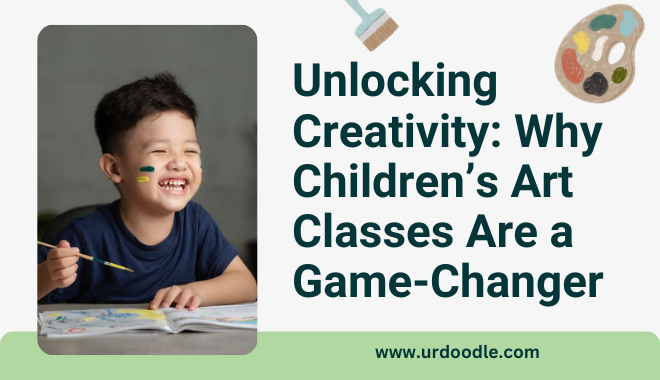In a world where kids are constantly glued to screens, finding creative outlets for them is more crucial than ever. That’s where children’s art classes come in—a magical escape where young minds can paint, draw, and sculpt their way to a more imaginative future. Let’s dive into why these classes are not just a fun pastime but a must-have experience for every child.

Why Art Classes Matter for Kids
Boosting Creativity:
Let’s be real—kids are like little sponges, soaking up everything around them. Art classes give them the perfect platform to express themselves in ways that words sometimes just can’t. Whether it’s through messy finger painting or mastering brush strokes, creativity blossoms in these sessions.
Improving Focus and Patience:
Ever watched a kid painstakingly color within the lines? Art teaches them to focus and stay patient. Sure, it might start with crayons and scribbles, but these skills translate into better concentration and persistence in other areas of life.
Building Confidence:
Handing a kid a blank canvas can be intimidating, but when they step back and see their masterpiece, the pride is unbeatable. Art classes help kids see that their ideas matter and that their efforts create something meaningful.
Types of Children’s Art Classes You Should Know About
- Painting Classes:
Perfect for budding Picassos, these classes teach kids the basics of watercolor, acrylics, and even oil painting. They’ll learn about color mixing, brush techniques, and composition. - Drawing Classes:
From sketching cartoon characters to realistic portraits, drawing classes cater to kids with a knack for pencils and paper. - Sculpting Classes:
Who doesn’t love a bit of hands-on fun? Sculpting lets kids play with clay, wire, or even recycled materials to create 3D masterpieces. - Digital Art Classes:
In this tech-driven age, digital art classes are all the rage. Kids learn to use tools like Procreate or Photoshop to bring their visions to life. - Themed Workshops:
Think holiday crafts or summer art camps—these short-term workshops are great for introducing kids to art in a fun, low-pressure environment.
The Hidden Benefits of Art Classes
Children’s art classes aren’t just about learning how to hold a paintbrush or mix colors; the benefits stretch far beyond the surface. While it’s easy to see the creativity and fun on display, the deeper, often hidden advantages of these classes are what truly make them a game-changer. Let’s take a closer look at how art impacts various aspects of a child’s development.
1. Building Emotional Intelligence
Art provides a safe space for kids to express their emotions. Sometimes, children don’t yet have the vocabulary to articulate their feelings, but through painting, drawing, or sculpting, they can communicate what’s on their minds without saying a word. For example, a child might use bold colors and intense strokes to depict anger or soft, delicate patterns to convey calmness. This emotional outlet can help kids process complex feelings and build emotional resilience over time.
Additionally, discussing their artwork with peers or teachers often leads to meaningful conversations, teaching kids to empathize with others and understand different perspectives. It’s like therapy—but way more fun and colorful.
2. Strengthening Problem-Solving Skills
Creating art is filled with challenges:
- How do you blend two colors to get the perfect shade of green?
- What’s the best way to make a clay sculpture stand upright without collapsing?
- How do you fix a mistake without starting over?
These questions push kids to think critically and experiment with solutions. They learn that mistakes aren’t failures—they’re opportunities to try something new. This ability to think outside the box and tackle problems creatively will serve them well in school, work, and life.
3. Enhancing Motor Skills and Coordination
For younger kids, art classes are a fantastic way to improve their fine motor skills. Activities like holding a paintbrush, cutting paper, or molding clay require precision and control, which helps develop the small muscles in their hands and fingers. These skills are essential for everyday tasks, from writing and tying shoelaces to playing musical instruments.
Older kids benefit too, as more advanced techniques—like shading with pencils or working with intricate patterns—further refine their hand-eye coordination. The physical act of creating art builds their dexterity and prepares them for tasks that require steady, skilled hands.
4. Fostering Independence and Decision-Making
Art is all about choices:
- Which colors should I use?
- What should I draw today?
- How should I position this sculpture?
When kids are given the freedom to make these decisions, they develop a sense of independence. They learn to trust their instincts and understand that their choices have value. This autonomy helps them become more confident decision-makers, a skill that’s vital as they navigate the complexities of growing up.
5. Cultivating Perseverance and Patience
Art isn’t always easy—it takes time and effort to create something meaningful. Kids quickly learn that rushing through a project often leads to mistakes, while patience and persistence yield the best results. For example, a child might spend hours perfecting the details of a portrait or carefully layering colors to achieve the perfect gradient.
This sense of perseverance carries over into other areas of their lives. Whether it’s studying for a big test, practicing a sport, or solving a tough math problem, kids who’ve developed patience through art are better equipped to stick with challenges until they succeed.
6. Boosting Self-Confidence
There’s nothing quite like the feeling of accomplishment kids experience when they finish an art project. Whether it’s a painting, a sculpture, or even a simple doodle, seeing their work on display—whether at home, school, or an art exhibit—fills them with pride.
Art classes help kids realize that their ideas and efforts matter. Even if their creation doesn’t turn out exactly as planned, the process itself teaches them to appreciate their abilities and celebrate their progress. Over time, this builds a strong sense of self-worth and confidence that extends far beyond the art studio.
7. Encouraging Collaboration and Teamwork
While art is often seen as a solo activity, many classes incorporate group projects and collaborative activities. Working together to create a mural, plan an exhibit, or brainstorm ideas teaches kids how to communicate effectively and share responsibilities. They learn to listen to others’ ideas, compromise when necessary, and celebrate collective achievements.
These teamwork skills are essential for navigating relationships and group dynamics in school, sports, and eventually, the workplace. Plus, the friendships forged during art classes often last long after the paint has dried.
8. Nurturing a Lifelong Appreciation for Art and Culture
Art classes expose kids to a wide range of artistic styles, techniques, and cultural influences. They might learn about famous artists like Van Gogh, Frida Kahlo, or Banksy, or explore art forms from different parts of the world, like Japanese ink painting or African tribal masks.
This exposure broadens their horizons and fosters a lifelong appreciation for creativity and culture. Even if they don’t pursue art as a career, they’ll carry this appreciation with them, enriching their lives in countless ways.
9. Supporting Mental Health
The mental health benefits of art can’t be overstated. Studies have shown that creative activities reduce stress, anxiety, and depression by promoting mindfulness and relaxation. For kids, this is especially important as they navigate the pressures of school, friendships, and family life.
Art classes provide a peaceful, judgment-free zone where kids can unwind and focus on the present moment. Whether they’re painting a serene landscape or sculpting a whimsical character, the act of creating art helps them feel calmer and more grounded.
10. Inspiring a Sense of Curiosity and Wonder
Art has a way of making kids ask questions and explore possibilities. Why does mixing blue and yellow make green? How can I make this clay feel smoother? What if I tried using leaves as paintbrushes? These moments of curiosity spark a lifelong love of learning and exploration.
Encouraging kids to experiment and ask “what if” helps them see the world through a lens of wonder and possibility. This mindset is the foundation for innovation and discovery, whether in art, science, or any other field.
Final Thoughts on the Hidden Benefits of Art Classes
Art classes are so much more than just a fun activity—they’re a powerhouse for personal growth, skill development, and emotional well-being. From building confidence and patience to fostering teamwork and curiosity, the benefits of these classes touch every aspect of a child’s life.
So, the next time you see a kid happily painting or sculpting away, remember: they’re not just creating art—they’re building a brighter, more creative future for themselves. Now, isn’t that something worth celebrating?
What to Look for in a Good Art Class
Finding the perfect art class for your child can feel like searching for a needle in a haystack. With so many options out there, it’s easy to get overwhelmed. But don’t worry—I’ve got your back. Let’s break down exactly what to look for so you can find a class that’s the perfect fit for your little Picasso.
1. Experienced and Kid-Friendly Instructors
This one’s a no-brainer. A good art instructor can make or break the class experience. Look for teachers who not only have solid artistic skills but also know how to engage with kids. Patience is key—after all, kids are bound to spill paint, ask a million questions, and sometimes stray off task.
Here are some things to keep in mind:
- Does the teacher have experience working with children of your kid’s age group?
- Are they encouraging and positive?
- Do they take the time to explain techniques in a way that kids can understand?
Pro tip: Sit in on a trial class if possible. You’ll quickly get a sense of whether the instructor is a good fit.
2. Class Size and Individual Attention
Nobody wants their kid to feel lost in the shuffle. Smaller class sizes are ideal because they ensure each child gets plenty of one-on-one attention. When instructors can focus on individual students, they’re better able to nurture each child’s unique talents and address their challenges.
For younger kids, a class size of 8–12 students is usually perfect. For older kids, slightly larger groups can work, especially if there’s an assistant or co-instructor to help out.
3. A Variety of Artistic Mediums
Kids thrive on variety, and art classes are no exception. The best classes expose children to a wide range of materials and techniques, from traditional painting and drawing to less conventional methods like collage, printmaking, or even digital art.
Here’s a quick checklist of materials and mediums to look out for:
- Paints (watercolor, acrylic, tempera)
- Pencils, markers, and crayons
- Clay or other sculpting materials
- Mixed media (think glitter, feathers, buttons, etc.)
- Digital tools like tablets or graphic design software
The more opportunities kids have to experiment, the more likely they are to discover what they’re passionate about.
4. A Relaxed and Fun Atmosphere
Let’s face it—art should be fun. Kids need an environment where they feel free to experiment and make mistakes without fear of judgment. Look for classes that emphasize creativity over perfection and encourage kids to express themselves.
Here are some signs of a relaxed atmosphere:
- Kids are chatting and laughing while they work.
- There’s no pressure to create “perfect” art.
- The classroom is colorful, welcoming, and maybe even a little messy (because that’s how you know kids are having a blast).
Avoid classes that feel overly rigid or competitive. The goal is to inspire creativity, not stifle it.
5. Age-Appropriate Curriculum
Not all art classes are created equal, especially when it comes to age groups. A class that’s perfect for a preschooler might be boring for a teenager and vice versa. Make sure the curriculum is tailored to your child’s developmental stage and skill level.
Here’s a general breakdown of what to expect:
- Ages 3–5: Focus on basic motor skills, simple shapes, and lots of fun! Think finger painting, sponge stamping, and other hands-on activities.
- Ages 6–8: Kids at this age can start learning basic techniques like blending colors or drawing simple objects.
- Ages 9–12: This is when kids start developing more complex skills, like shading, perspective, and working with different mediums.
- Ages 13+: Teens often prefer classes that let them explore their personal style or tackle more advanced projects.
6. Clear Goals and Structure
While creativity should be the main focus, a little structure goes a long way. Look for classes that have a clear plan for each session, whether it’s learning a new technique, completing a specific project, or exploring a particular theme.
Ask the instructor questions like:
- What skills will my child learn in this class?
- Will there be a final project or showcase?
- How do you balance instruction with free exploration?
A good balance between guidance and freedom is key. Kids should feel supported while still having the space to explore their own ideas.
7. Opportunities for Feedback and Growth
Constructive feedback is essential for helping kids grow as artists. Look for classes where instructors provide gentle, encouraging critiques that focus on effort and improvement rather than just the end result.
For example:
- Instead of saying, “This part looks wrong,” a good teacher might say, “You’re doing great with shading! Let’s try adding a bit more contrast here to make it pop.”
- Classes that include progress reports or informal reviews can help kids (and parents) see how far they’ve come.
8. Flexible Scheduling
Life with kids is busy—no doubt about it. Look for art classes that offer flexible scheduling options, whether it’s after-school programs, weekend sessions, or even drop-in workshops. Many studios also offer make-up classes in case your child has to miss a session.
Bonus points if the class is close to home or school—because let’s be honest, nobody wants to spend hours driving across town.
9. Showcase Opportunities
There’s nothing more exciting for a young artist than seeing their work on display. Some art programs host end-of-term showcases or gallery nights where kids can share their creations with family and friends. This not only boosts confidence but also gives kids a taste of what it’s like to be a “real” artist.
10. Cost and Value
Let’s talk about the elephant in the room: money. While some art classes can be pricey, remember that you’re investing in your child’s development. That said, make sure the cost aligns with what’s being offered.
Here are a few things to consider:
- Does the fee include materials, or will you need to buy your own?
- Are there discounts for siblings or multi-class enrollments?
- How experienced are the instructors, and is the facility well-equipped?
Don’t be afraid to shop around and compare options to find the best value for your budget.
11. Online vs. In-Person Classes
In the post-pandemic world, online art classes have become more popular than ever. But how do they stack up against traditional in-person classes? Here’s a quick comparison:
- Online Classes: Convenient, often more affordable, and great for kids who prefer working from home. Just make sure you have the necessary supplies and a reliable internet connection.
- In-Person Classes: Offer a hands-on experience with access to studio-quality materials and face-to-face interaction with instructors and peers.
Both options have their pros and cons, so choose the one that works best for your child’s needs and schedule.
Wrapping It Up: Finding the Right Fit
When it comes to children’s art classes, there’s no one-size-fits-all solution. The best class for your child depends on their age, interests, and skill level—not to mention your budget and schedule. But by keeping these tips in mind, you’ll be well on your way to finding a class that sparks your child’s creativity and helps them grow as an artist.
At the end of the day, it’s all about giving your kid the tools and support they need to explore, experiment, and have fun. So, start exploring your options, and watch as your little artist’s confidence and creativity soar!
Tips for Parents Supporting Their Budding Artists
- Create a Mini Art Studio at Home:
Set up a space with basic supplies—crayons, markers, paper, and maybe even an easel. - Celebrate Their Creations:
Hang their artwork on the fridge or frame it for the living room. Trust me, it’ll mean the world to them. - Encourage Exploration:
Let them try different mediums and styles without worrying about making a mess. - Enroll Them in Classes Early:
The earlier they start, the more time they’ll have to develop their skills and confidence.
FAQs About Children’s Art Classes
1. At what age should kids start art classes?
Most kids can start as early as 3 or 4 years old. At this age, classes focus on basic motor skills and having fun rather than perfecting techniques.
2. Are online art classes effective for kids?
Absolutely! Virtual classes can be just as engaging, especially if they’re interactive and come with clear, step-by-step instructions.
3. How often should kids attend art classes?
Once or twice a week is a good starting point. This gives them enough time to practice at home without feeling overwhelmed.
4. What if my child doesn’t seem interested in art?
That’s okay! Try introducing them to different types of art or mixing it up with short-term workshops to see what sparks their interest.
Conclusion: Let Their Creativity Soar
Art classes aren’t just about creating pretty pictures—they’re about shaping well-rounded, confident, and creative individuals. Whether your child is a future Van Gogh or just needs a creative outlet, these classes are a game-changer. So, what are you waiting for? Get your little artist signed up today and watch their imagination run wild.
For more tips and inspiration, visit urdoodle.com. We’re here to help you unlock your child’s artistic potential one masterpiece at a time!



